Chris Baty's Blog, page 21
September 1, 2022
Community Fundraising Means Showing Up for Each Other
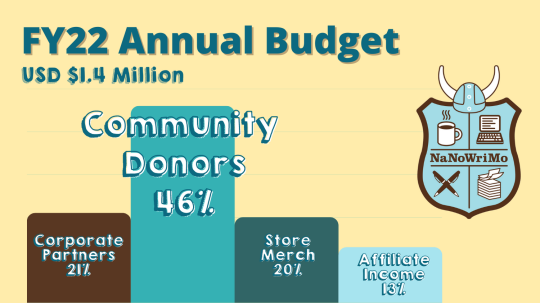
Let’s talk interdependence and donor support today with our Director of Community Fundraising, Allison Celosia. She wants you to feel empowered as a returning or first-time donor to NaNoWriMo and our broader literary arts community.
Image id: A yellow and teal graphic of a bar chart entitled “FY22 Annual Budget USD $1.4 Million.” There are four bars, from left to right Corporate Partners 21%, Community Donors 46%, Store Merch 20%, and Affiliate Income 13%.
Did you know that NaNoWriMo is story-powered by more than 8,000 individual donors every year? In fact, more than 45% of our annual revenue comes from community members like you.
This year, our annual operating budget is $1.4M… aka, we have to raise $1.4M in funding to sustain our amazing community and writing programs. (For the super math nerds, that’s more than $600K from community members alone. Whoa! That’s donor power!)
This annual budget plan ensures that we offer our programs free-of-cost to all our participants. We want to provide everyone access to their stories, to their imagination, to the overall joy of writing and reading. Eliminating a paywall is one HUGE way we can do that for our community.
But ahh, what does that look like in context with everything going on in the world? We’re seeing news headlines about the highest U.S. inflation rate in 40 years. This means a carton of eggs is 3 times the price as it was last year, gasoline is USD $7 per gallon in some cities… the list of commodity price pain points are endless. Same goes in the U.K., Canada, Germany, India, and so many other countries where Wrimos live, work, and write.
For me as a community fundraiser, historic inflation rates might spark fear and anxiety. I might feel pressure to “do whatever it takes to get that cash.” But that’s not me! I’m an abundance mindset fundraiser. I’m a humanity-comes-first fundraiser. I’m good with reorienting our metrics to better reflect our economic reality because at the end of the day, I know that our community—myself, the rest of the NaNo staff and board, and all of our 8,000 donors and counting—are doing the best we can to invest in the good health of our creative community.
We are about to enter our fall fundraising season with two big campaigns ready to mobilize all our community resources: NaNo Prep and our Double Up Donation Weekend. In a few weeks, I will be inviting all of us to give within our means, and that is really an invitation to be thoughtful about your own financial power and privilege.
For many of us, it means donating to NaNoWriMo this year might look a lot different.
Maybe you want to give, but feel pressured to give at a certain amount and it has frozen you from making any contribution at all. My response is, “That’s fine! Would moving to a monthly recurring donation help ease the financial commitment? That way, it’s not a lump sum donation but a smaller donation once a month.”Maybe your donor interests lie elsewhere this year because of, well… gestures at the state of the world. My response, “Awesome! Do you want help budgeting, so you can make meaningful donations to all the causes that matter to you? We can do that!”Maybe you are straight up mad that rent is high and groceries are more expensive, and you don’t wanna hear from me asking for money. My response, “I hear you. I’m a renter in Los Angeles, and am feeling similar pains. Fundraising can feel extractive. After reading Edgar Villanueva’s Decolonizing Wealth as a staff team, we learned that we could reframe money as a tool for building love and restoration, rather than for punishment or penalty. You’re an important member of this community, no matter your donation level or even if you donate zero zip zilch at all.Ultimately, we hold each other accountable and we also hold each other tenderly when it comes to mobilizing donor dollars to sustain NaNoWriMo as an available, inclusive resource for hundreds of thousands of writers around the world.
The math of raising $600,000 from community donors doesn’t go away with hard times. We need those funds to keep our programs accessible and free-of-cost. Our annual budget covers personnel expenses, technology needs to support more than 350,000 Wrimos annually, and a merchandising store and fulfillment center to provide fun writers’ tools and goodies to support us along our writing journeys.
That’s when I remind myself that we’re a community first. We can rely on each other and step up wherever we can. Maybe this is the year we move from 8,000 donors to 10,000 donors to share the work of raising funds, maybe this is the year we build out more partnership drives to build resources with like-minded organizations and friends—the opportunities are limitless when we prioritize mutual support and interdependence as ways to sustain NaNoWriMo and our entire creative community.
Stay tuned, as I continue to wax poetic and bring more community support into our fundraising efforts here at NaNoWriMo.

Allison Celosia is a storyteller, written word mostly. She edits aloud in real time and trips over their native Bisaya (Filipine) tongue. Allison is also a movement building fundraiser who centers community relationships in their work. Outside of fundraising, they are active in local labor organizing. She makes challah bread with her own home-milled flour and reads bilingual children’s books with her nephew every chance they get.
August 9, 2022
Lessons from a Twenty-Year NaNoWriMo Run

What lessons have you learned during your experiences doing NaNoWriMo? Long-time participant Kathy Kitts shares some of the takeaways from her impressive twenty-year streak of writing novels:
NaNoWriMo has always been an important part of my November, but this year it’s more so. It will mark my twentieth win in a row. (If I make it. No pressure.)
When HQ found out about this big milestone, they asked me to describe the lessons learned over the years as a participant, Municipal Liaison (a.k.a. ML, a volunteer regional leader), ML mentor, site debugger, ML handbook contributor, fundraiser, translator, and occasional MOD. (If you stick around long enough, nonprofit organizations will always find something for you to do.) I agreed. Why? Because NaNoWriMo has had such a profound influence on me, it actually altered the direction of my life.
2003 – The First Year. At the time, I was a planetary science postdoc and should have been concentrating on my research, but I was tired of writing about what is. I wanted to write about what if. Except, what if I failed? Taking no chances, I told no one. Under the name Apollo16, NaNoWriMo became my late-night secret. And I won! I donated out of gratitude and got a tiny little pin that read: I WRITE BOOKS. Nah! It was a fluke, a one-off. That “s” was a problem.
2004 – October Is For Preparation. This is when I learned about crockpots. You could make a bunch of soups and stews and freeze the leftovers. I won and treated myself to a chest freezer. You know, in case I tried for a third year. (And yes, that sucker is still running.)
2005 – The Magic of Write-ins. Being brave, I told a few friends about this November writing thingy, and we had our own unofficial write-in. I fetched my “I WRITE BOOKS” pin and wore it to our celebration party. Three was a big enough plural.
2006 – Cheap Halloween Candy and Perth, Australia. As a newly minted ML, I passed out pixy stix at every write-in. (Or as it is known in Wrimo circles, Writer’s Crack.) As for Perth, our two regions fought word wars, exchanged care packages, and egged each other on. I can still taste the Tim Tams, and they are probably still buzzing from the pixy stix.
2007 – Some People Lack Imagination. While running a word war, a Wrimo yelled out, “How much time do we have? I have to kill someone.” I shouted back, “Seven minutes. I could kill billions in seven minutes.” All twenty plus writers whooped in agreement. A woman who had just purchased her coffee stared at us in horror. She backed out of the coffee shop not daring to stop and collect her change.
2008 – The Muse and Flexibility. Many Wrimos have significant others who are not writers. Shocking but true. To make them feel loved before we utterly abandoned them for a month, we hosted a Halloween party from 9 to 12. At 12:01 AM November 1, we pulled out the power strips, sent the non-writers packing, and started typing. Up to this point, I’d always considered myself a “plotter.” Such a hardcore plotter, I once calculated the amount of CO2 in the atmosphere of an alien world to get the weather I wanted. With my stack of notes at the ready, prepared to bang out my 1667, a little boy appeared, saying, “You have to tell my story.” I argued, “But I have all these orbital calculations!” Didn’t matter. I learned not to argue with the muse and that flexibility makes winning easier.
2009 – How to Suck It Up. That was a terrible slog of a year. I really wasn’t feeling it. I was farting around on the forums when I met a Wrimo who had to finish early. Why? She was deployed in Iraq. She had put her novel on a CD, handed it to her CO, who returned to the base, and uploaded it for her so she could win. Yeah, no inspiration there. I faked a cough to get out of a faculty meeting to make my word count.
2010 – The Reach of NaNoWriMo. To make new friends after my move, I volunteered at the local community library. I was shelving books, when someone shouted, “Apollo16! Is that you? Mom! It’s Apollo16!” I recognized one of my Young Writers from Chicago. Her family had moved a couple of months before I had. She dragged over her mother and explained how excited she was to still have her Wrimo friends. Her mother gave me the eyeball and said, “You know, she’s going to be a writer now. It’s all your fault.” I grinned. “No, ma’am. It’s Chris Baty’s fault.”
2011 – Debugging and Love. With the growth of NaNoWriMo worldwide, the old website just couldn’t hack it. After some fundraising, we moved on from Druenemy (okay, Drupal but that’s not what we called it) to Ruby on Rails. We had a massive “debugger” team that spanned the globe. We slew bugs like they were dragons and we were Knights of the Round Table. Few organizations could ask and get so many volunteers to donate so much time and resources. It was awe-inspiring.
2012 – No Plot No Problem v. 2. Chris Baty asked a bunch of the MLs to provide quotes for his second edition of No Plot No Problem. All the lessons I’ve learned can be found in that book. While you wait for it to be delivered, here are three I shared with him. (1) Buy lots of underwear for the entire family so you won’t have to do as much laundry. (2) Rack up a bunch of childcare credits early in the fall. That way they are beholden to you and can’t weasel when November rolls around. (3) As for the transition to normal life, sometimes it doesn’t happen. Sometimes you get the strength to retire early or change careers so you can continue to write. This quote will haunt me later.
2013 – The Year I Tried To Cheat. I decided to turn one of my scripts into a novel. Should be simple, right? Nope. At day 18, I hit the wall. The script was a script and not a novel. Panicked, after this long of a run, I had to win! I was an ML, a mentor! So, I did what I’ve told countless other Wrimos to never do. I deleted the whole dang thing, all 30,00 words. On day 19, I came clean and started over with a blank page. I made 50,284 at 11:52 PM on Nov. 30.
2014 –The Night Of Writing Dangerously. The year I finally got to attend. To go to San Francisco. To have dinner in that fantastic ballroom. To sew a costume for the grand event. Unfortunately, I had just developed a food allergy. How could I go and not be able to eat? Grant Faulkner and Sarah Mackey invited me to come up to the buffet table and serve myself first to avoid cross-contamination. The staff of the Office of Letters and Light didn’t just care about writing, but about the writers too. Did I win that night and get to ring the bell? No. I wrote a total of six words. Yet, I was so inspired, I finished early. I didn’t have to hide in the bathroom with my laptop during Thanksgiving like all the other years.
2015 – The Grad Student Figures It Out. When you are the prof, you get to make up the syllabus and control the timeline. For years, mysteriously, there were few tests, problem sets, or projects due in November. Occasionally, one of my grad students would join me for NaNo. In the middle of a write-in, one such grad student jumped to their feet and shouted, “Oh my god! It was never about us! About being nice to us during crunch month! It was always about NaNoWriMo!” Duh.
2016 – Lack of Imagination Part II. That year at our write-in, a guy walked into our section with his food, shot us a judgy glare as we typed, and plunked down opposite my table. A new Wrimo began to cry. I asked her, “Are you okay?” “Yes,” she sniffled, “I just killed someone. I’m embarrassed.” “Oh don’t worry, we all cry when we kill someone. It means you’re doing a great job.” The guy’s eyebrows met his hairline and he hustled right back from whence he came. For the record, this time, we did have signs up everywhere.
2017 – Catch-22. This is the year I started to teach creative writing on the side. Being new and unknown, I feared nobody would sign up. My Wrimo buddies filled the class. I told them how grateful I was. They said the joke was on me. “Now, you have to read all of our novels.” D’oh!
2018 – The Prof Figures It Out. That was the year I taught NaNoWriMo. Got paid to do what I was going to do anyway.
2019 – Website and Young Writer Redux. Technology marches on and we fundraised for yet another website that folded NaNo, Camp, and Young Writer’s into one place. Speaking of young writers, remember the girl from 2010? She got a novel published, and dedicated it to her Wrimo support group.
2020 – 2021 The COVID Years and Family. I was never worried about the survival of the Office of Letters and Light. The support runs too deep, but what of the local groups without in-person events? Silly me, the pivot went without a hitch. We ended up having Zoom write-ins for thirty days straight during both Novembers. Even on Thanksgiving. Why? Because we’d become family. But mostly, because we didn’t force anyone to eat lime Jell-O with an expired can of fruit cocktail suspended inside it like a scene from The Blob.
2022 – Twenty Years and A Million Words. According to my lifetime word counter, I have written 1,380,023 words. However, that number includes all my revisions from Camp. In my heart of hearts, I know I won’t break 1,000,000 until this November. Malcolm Gladwell suggests that we become experts at the 10,000-hour mark of working our craft. Several writers have translated that as 1,000,000 words. I’ve been selling my work since 2010, but with 1,000,000 words so close, I have faith that some of those words might be good words.
Remember, up at the top of this stroll down memory lane, I mentioned how NaNoWriMo altered the course of my life? After twenty plus years as a planetary geologist, I have retired. This fall I will be starting over as a graduate student in an MFA program in Creative Writing. But this time, it isn’t entirely Chris Baty’s fault. It’s Grant Faulkner’s too. He wrote one of my letters of rec.
See ya in November!
Dr. Kathy Kitts, AKA Apollo16, is a planetary geologist who has served as a science team member on the NASA Discovery Mission Genesis among others. Her latest speculative short fiction has appeared in Compelling SF, James Gunn’s Ad Astra, and Amazing. She has a collection of stories titled Getting What You Need available worldwide on Amazon. Born and raised in the desert southwest, she is moving from New Mexico to Alaska mostly because she isn’t dead yet.
Top photo by Nils Stahl on Unsplash.
August 2, 2022
We’re Looking for Two Fall Interns!
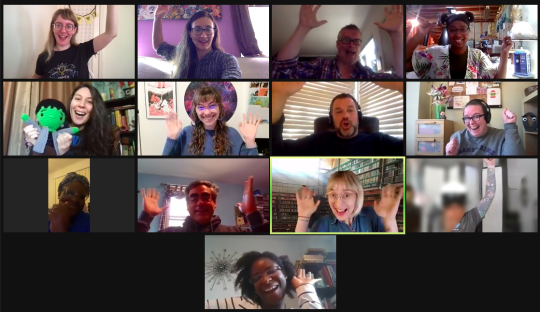
Want to join the NaNoWriMo team? We’re currently hiring two paid, part-time, remote interns for the fall: one Editorial & Programs Intern, and one Marketing & Fund Development Intern. Our interns are deeply appreciated, and become fully integrated into our team. You can find more details about the positions below.
NaNoWriMo Fall 2022 Internship OverviewInternship Requirements:
Must be available from September 1, 2022, to December 15, 2022, for 12 hours per weekMust be available at least 2 days per week (M-F)Must be located in the United StatesMust be at least 18 years oldMust have access to reliable internet and computer/equipment that enables video conferencingMust be passionate about writing, education, non-profits, and/or or building and working with online communitiesThe ideal candidates will have the opportunity to support projects based on experience and organizational need.
We will consider every application carefully and holistically, so please don’t hesitate to introduce yourself—even if your experience doesn’t line up exactly with this list. We don’t expect anyone to have experience with all of these categories, but look forward to seeing applicants with different combinations of experience.
Editorial & Programs Intern
Someone who loves meeting new people and engaging in digital communityExcellent writing and editing skills, especially for online non-fiction content (i.e. blogs, newsletters, etc.)Virtual facilitation and leadership skills (i.e. Discord, Twitch, Zoom, forums, etc.)Video filming and editing experience; familiarity with YouTubeMarketing & Fund Development Intern
Someone who loves to build relationships through branding and storytellingSocial media savvy (especially TikTok and/or Instagram)Curiosity around community fundraising and the ways we give charitablyResearch know-how and excitement around systems and operationsAdditional skill sets that would be supportive in either of these roles:
Non-profit experience (paid and/or volunteer capacity)Experience with Wordpress or HTMLGraphics creation and editing (i.e. digital and/or physical art, experience with Photoshop, Canva, etc.)Project managementAbility to work well with a teamTime management / the ability to meet deadlines for simultaneous projectsCreative idea generation, and enthusiasm to take ideas from theory to practiceFamiliarity with NaNoWriMo’s programs and eventsA creative practice
Interns receive training from our staff, and learn skills related to:
Content creation for websites and emailsWorking with authors, designers, and other contributorsHosting YouTube live-streams and Zoom eventsManaging organizational social media accountsPublic relations and media outreachData organization and interpretationSupporting student writers and organizational volunteersNonprofit operations and administration
General administrative tasks may be asked of all interns. In addition to learning about the nonprofit sector, our interns acquire skills they can apply to careers in technology, the literary arts, press/communications, and program management.
Location and hours: This is a part-time, temporary, remote position. Attending regular video meetings is required. Interns must live in the United States. This internship cycle runs for 15 weeks, beginning September 1, 2022. Interns must be able to commit to 12 hours per week, and must be available at least two days per week (M-F).
Compensation: This internship pays $18/hour. We can complete any documentation needed for college credit hours. Interns also get free NaNoWriMo merchandise, plus buckets of gratitude from staff and our participants all around the world.
NaNoWriMo is committed to diversity and building an inclusive environment for people of all backgrounds, and we are taking steps to meet that commitment. Our community-at-large includes women, people of color, LGBTQIA+ people, and people with disabilities, and we highly encourage folks from these communities to apply.
To apply, please fill out the Internship Application form. Although the volume of applications we get may prevent us from responding to everyone, you will get a confirmation that your application has been received.
Applications are open through Sunday, August 14. Will be in touch with applicants by Friday, August 19, if we’d like to schedule a video interview.
July 29, 2022
“When you’re in the final stretch of drafting, it’s worth...
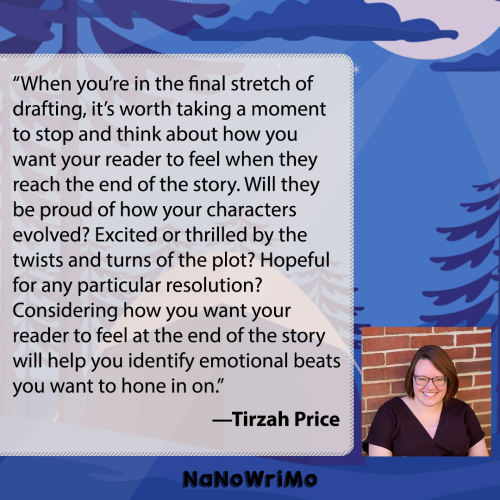
“When you’re in the final stretch of drafting, it’s worth taking a moment to stop and think about how you want your reader to feel when they reach the end of the story. Will they be proud of how your characters evolved? Excited or thrilled by the twists and turns of the plot? Hopeful for any particular resolution? Considering how you want your reader to feel at the end of the story will help you identify emotional beats you want to hone in on.”
—Tirzah Price is the author of the Jane Austen Murder Mysteries, published by HarperTeen, and a senior contributing editor at Book Riot. She holds an MFA in Writing for Children and Young Adults from Vermont College of Fine Arts.
July 27, 2022
Writing a Book About a Family Member
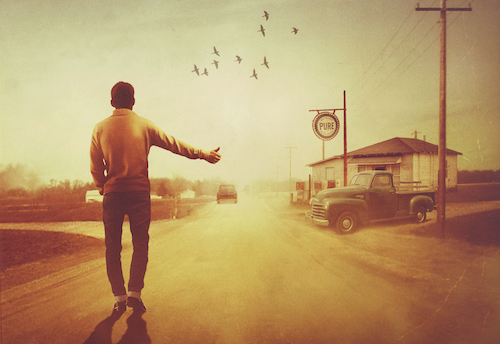
One of the hardest parts about writing a memoir is figuring out how to write about the people closest to you. What do you share, and what do you leave out? Today, author Mary Ford shares some advice about writing characters based on someone you know in real life:
My book Boy at the Crossroads: From Teenage Runaway to Class President, was inspired by true events. The coming-of-age story depicts an adolescent who grew up impoverished and with minimal affection, but still found the strength to follow his gut toward something more.
My husband encouraged me to write his story. That was the easy part. The challenge was pulling the story together in an interesting and cohesive way.
Being married for forty-nine years meant I knew my subject well. He told me about his teenage exploits after we started dating. I knew back then; I had the core of a story that might just pull readers in. For starters: My husband is the fifteenth of sixteen children; he ran away from home at thirteen; and hitchhiked his way around the deep South. He ended up selling hotdogs in New Orleans. It was 1955.
In 1987, we settled in Massachusetts. Our kids were in school and I went to work full-time for the local newspaper. I asked my husband to talk into a tape recorder on his annual, two-day-long driving trips home from Massachusetts to Tennessee.
His memory for the smallest detail is remarkable. Over some twenty years, I had dozens of miniature cassettes for research.
Retirement from my long career as a newspaper editor nearly four years ago provided me with the opportunity to transcribe the tapes and start drafting the story.
Having a willing subject made the writing easier. The dilemma was: what to leave on the cutting-room floor? My husband relished sharing all his anecdotes and vignettes, to the point where the story could’ve gotten lost in the proverbial “walk down memory lane.”
Best advice I received: if it doesn’t move the story forward, take it out!
Second best advice: Writing a novel inspired by a true story rather than a biography. Writing biographical fiction provided me with the freedom to enhance dialog and some scenes.
Third best advice: Leave the newswoman behind. No one wants to read a 250-page report. I had to learn how to be an author, not a reporter. That means using words to show what happened not just to tell what happened.
Writing is more a craft than an art. It requires rewriting and revising. Join writing groups and take classes to get started. If your goal is to have your book be enjoyed by a wider audience than friends and family—then listen to critiques, learn, and make the necessary changes.
I became a published author at seventy-two, so it’s never too late to write the book inside of you!

Mary Ford is a retired, award-winning journalist who spent twenty-eight years as the editor of two successful, small-town newspapers in Massachusetts. She and her husband, Conley, live in a small town south of Boston, with their dog, George. Boy at the Crossroads: From Teenage Runway to Class President is a classic coming-of-age story set in the 1950s. For more about Mary Ford and her novel, visit: maryfordedit.com. Boy at the Crossroads is available online wherever books are sold.
July 21, 2022
“In fiction, setting can be an under-utilized tool. It should be...
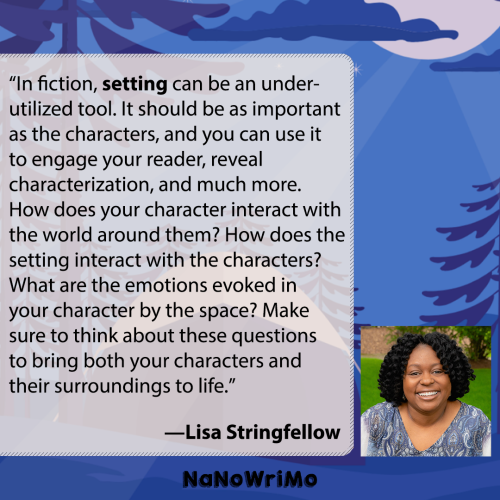
“In fiction, setting can be an under-utilized tool. It should be as important as the characters and you can use it to engage your reader, reveal characterization, and much more. How does your character interact with the world around them? How does the setting interact with the characters? What are the emotions evoked in your character by the space? Make sure to think about these questions to bring both your characters and their surroundings to life.“
—Lisa Stringfellow writes middle grade fiction and has a not-so-secret fondness for fantasy with a dark twist. Her debut fantasy A Comb of Wishes was published on February 8, 2022 by HarperCollins/Quill Tree Books and was named an ABA Indie Introduce and an Indie Next Kids’ title. The book has received starred reviews and is included on 2022 summer reading lists by The Horn Book and the TODAY show’s Read With Jenna Jr. Lisa’s work often reflects her West Indian and Black southern heritage. She is a middle school teacher and lives in Boston, Massachusetts, with her children and two bossy cats.
July 18, 2022
World-building a Diverse Landscape
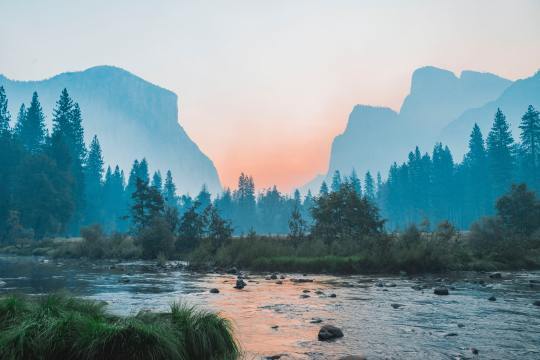
If you’re working on making a big and immersive world for your story, NaNoWriMo writer Siera Schubach has some tips for building different kinds of landscapes into your novel:
The wonderful part of writing fantasy is you don’t have to rely on reality.
However, there is much inspiration that can be drawn from the real world that will enhance your worldbuilding efforts.
Landscapes in particular can lend believability to your fantasy world, as well as inform plot and character creation. Here are a few ideas and tips to help you on your worldbuilding journey.
Think Outside the ForestWhen we think of landscapes, a few broad categories may come to mind:
DesertForestMountainsPlainsIf you look at the landscape of any country, you will see variations on each of these broad types. There are high deserts filled with sage brush, and coastal deserts flanked by ocean. Mountains can be tall and sharp, or sloped and smooth. And forests can grow trees in every size from as tall as the giant sequoia, to as small as pinyon pines.
In my travels this summer, I have seen some beautiful landscapes I never knew existed. Here are few that have inspired me:
Pyramid Lake, NevadaGreat Sand Dunes, ColoradoBadlands, South DakotaPanther Creek Falls, MontanaCove Palisades, OregonTip: If you are unable to travel, a browse through google images or national park websites can lead to some interesting discoveries.
Landscape and CharacterLandscape informs character in ways we don’t always consider. We have all been shaped one way or another by the physical landscape in which we grew up. Whether it be our understanding of the world, or just what we feel comfortable living within.
Say you have a character who was born on an island. They woke up each morning with the sound of ocean waves, surrounded by hibiscus flowers and mango trees. How might they be affected if they were suddenly moved to a desert?
If your fantasy world consists of non-human species, then landscape can also have an impact on their physiology. How might a character who grew up in a high mountain landscape have adapted to living in high altitude?
Take a moment and consider how you have been shaped by the landscape in which you grew up. How have your experiences changed as you’ve moved to different environments?Now consider one of your characters. How have they been shaped by the landscapes they experienced?Nature is MessyNature impacts us in a multitude of ways everyday. Whether it be allergies, or rainstorms, or a steep climb up a hill. Your characters should have the same relationship with it.
Consider the difficulties that can arise as they encounter different landscapes. Remember, there shouldn’t always be a path. Let your characters wade through the water, get tangled in the underbrush, lose their shoes in the mud.
Difficult terrain can be a catalyst for an argument or confrontation. Waiting for the tide to go out could lead your characters to finally have that difficult conversation. A beautiful view can inspire someone to admit their true feelings.
Let your landscape inform character decisions in the same way our real natural world informs our own.
Tip: Take a walk and pay attention to the landscape. What plants do you encounter? What beauty do you see?
Embrace the UnusualWe tend to view landscapes in simple terms. We can easily imagine a forest lined lake, or a desert brimming with cactus. But what about large rock formations in the middle of a plain? Or sand dunes at the base of verdant mountains? These are the sorts of unusual landscapes that make a world feel believable.
As I’ve written before, there is no need to know every single detail of your fantasy world before getting started. Instead, consider these ideas as you write and discover what makes your fantasy landscape unique. Challenge yourself to go beyond the basic lines of landscape to something a little more interesting.

Siera Schubach is an award-winning writer, storyteller, and random fact collector. She is currently in the depths of editing her latest fantasy novel, and working on a nonfiction book that will be published by Bloomsbury in 2024.
Worldbuilding a Diverse Landscape

The wonderful part of writing fantasy is you don’t have to rely on reality.
However, there is much inspiration that can be drawn from the real world that will enhance your worldbuilding efforts.
Landscapes in particular can lend believability to your fantasy world, as well as inform plot and character creation. Here are a few ideas and tips to help you on your worldbuilding journey.
Think Outside the ForestWhen we think of landscapes, a few broad categories may come to mind:
DesertForestMountainsPlainsIf you look at the landscape of any country, you will see variations on each of these broad types. There are high deserts filled with sage brush, and coastal deserts flanked by ocean. Mountains can be tall and sharp, or sloped and smooth. And forests can grow trees in every size from as tall as the giant sequoia, to as small as pinyon pines.
In my travels this summer, I have seen some beautiful landscapes I never knew existed. Here are few that have inspired me:
Pyramid Lake, NevadaGreat Sand Dunes, ColoradoBadlands, South DakotaPanther Creek Falls, MontanaCove Palisades, OregonTip: If you are unable to travel, a browse through google images or national park websites can lead to some interesting discoveries.
Landscape and CharacterLandscape informs character in ways we don’t always consider. We have all been shaped one way or another by the physical landscape in which we grew up. Whether it be our understanding of the world, or just what we feel comfortable living within.
Say you have a character who was born on an island. They woke up each morning with the sound of ocean waves, surrounded by hibiscus flowers and mango trees. How might they be affected if they were suddenly moved to a desert?
If your fantasy world consists of non-human species, then landscape can also have an impact on their physiology. How might a character who grew up in a high mountain landscape have adapted to living in high altitude?
Take a moment and consider how you have been shaped by the landscape in which you grew up. How have your experiences changed as you’ve moved to different environments?Now consider one of your characters. How have they been shaped by the landscapes they experienced?Nature is MessyNature impacts us in a multitude of ways everyday. Whether it be allergies, or rainstorms, or a steep climb up a hill. Your characters should have the same relationship with it.
Consider the difficulties that can arise as they encounter different landscapes. Remember, there shouldn’t always be a path. Let your characters wade through the water, get tangled in the underbrush, lose their shoes in the mud.
Difficult terrain can be a catalyst for an argument or confrontation. Waiting for the tide to go out could lead your characters to finally have that difficult conversation. A beautiful view can inspire someone to admit their true feelings.
Let your landscape inform character decisions in the same way our real natural world informs our own.
Tip: Take a walk and pay attention to the landscape. What plants do you encounter? What beauty do you see?
Embrace the UnusualWe tend to view landscapes in simple terms. We can easily imagine a forest lined lake, or a desert brimming with cactus. But what about large rock formations in the middle of a plain? Or sand dunes at the base of verdant mountains? These are the sorts of unusual landscapes that make a world feel believable.
As I’ve written before, there is no need to know every single detail of your fantasy world before getting started. Instead, consider these ideas as you write and discover what makes your fantasy landscape unique. Challenge yourself to go beyond the basic lines of landscape to something a little more interesting.

Siera Schubach is an award-winning writer, storyteller, and random fact collector. She is currently in the depths of editing her latest fantasy novel, and working on a nonfiction book that will be published by Bloomsbury in 2024.
July 16, 2022
“Read widely and read deeply. Read a mix of older works (so you...

“Read widely and read deeply. Read a mix of older works (so you know what’s come before you) as well as books released within the last few years so you have a good idea of what the market is like now. Reading, appreciating, and dissecting what’s already out there has helped me more than any writing class or craft book.”
—Mia P. Manansala (she/her) is a writer and certified book coach from Chicago who loves books, baking, and bad-ass women. She uses humor (and murder) to explore aspects of the Filipino diaspora, queerness, and her millennial love for pop culture. Her debut novel, ARSENIC AND ADOBO, has won multiple awards, and the sequel, HOMICIDE AND HALO-HALO, is out now. Find her on Facebook, Twitter, and Instagram: @MPMtheWriter
July 15, 2022
9 Ways to Tighten Up Your Novel’s Middle

Every year, we’re lucky to have great sponsors for our nonprofit events. Scrivener, a 2022 Camp NaNoWriMo sponsor, is an award-winning writing app that has been enthusiastically adopted by best-selling novelists and novices alike. Today, Scrivener director Julia Pierce is here to share some tips on writing your story’s middle:
We’re midway through Camp and around now, some of you may be starting to experience the curse of the saggy middle. This isn’t just a euphemism for what happens when the need to meet your daily word count target becomes all-consuming and takes precedence over your daily exercise routine. Nope, it’s that bit where the doubts about your story’s structure start to creep in… Is that storyline really as gripping as you first thought? Would the hero really make that choice…?
Unfortunately, writing the midsection of a novel is tricky—it’s where the hard work happens, the plot is driven on, characters grow and plans are tried (and fail). With this part taking up around 50% of the word count, a good rate of momentum is vital to carry the reader with you from your perfect beginning to the novel’s climax. So, how can you pep up your prose? Here are some tried and tested methods:
1. Get your outline in order.Even if you’re a pantster, a rough outline can really help you keep on the right path. Create plot points on index cards (or virtual index cards) to view your ideas and where you plan to go with them. Does each point flow logically with the final goal in mind?
2. Check your antagonist.Do they draw the reader to them? Is their motivation strong, and do they have enough power to make their anti-goal achievable? A good antagonist is sympathetic—but remember, not more so than the protagonist.
3. Make it complicated….Is your protagonist meandering from A to B? Why not make their life difficult? Throw in obstacles—then make them bigger and more complicated. With every heroic step forwards, does the villain also come closer to a win? Crank up the emotion. Make that hero earn their prize.
4. …But not too complicated.Nobody loves a story where the protagonist can’t catch a break. Add some wins for them, however small. Keep a spark of optimism alive to make their continued motivation to succeed believable.
5. Fuel inner conflict.No matter how determined your hero is, a good dose of inner conflict is the ideal tool for throwing them off the right path, raising the stakes and leaving the reader rooting for them to overcome their turmoil. Pull them in opposite directions between their inner and outer goals - a struggle is compelling reading.
6. Raise the stakes.What does the protagonist have to lose—or gain? Reinforce and heighten this as the story goes on, and remind your reader of the consequences of various outcomes.
7. Weave in a subplot.Show the reader (and hero) the dangers of failure through a secondary character’s eyes.
8. Throw in a midpoint reversal.An unexpected turn of events throws the plot sideways: shock your readers or tease them with a will it / won’t it event or a secret. Change up what the reader thinks they know to make the end unpredictable.
9. If all else fails…If you still can’t find the right way to firm things up, reset your brain by going for a walk, taking a nap, or playing a word game to revive your energy levels or maybe find the inspiration you need. Often, just disengaging your conscious mind and encouraging your subconscious to mull over your plot can be enough to tip you over into a flow state once again. Best of luck!
Julia Pierce is a former journalist who now writes for fun. She’s also a director at Literature & Latte, creators of the writing app Scrivener—the perfect tool for planning out, adding structure to or editing your book. Get some writing inspiration on the Write Now With Scrivener podcast here (https://podcast.scrivenerapp.com)
All Camp NaNoWriMo participants receive a 20% discount on Scrivener’s regular license by entering HAPPYCAMPER22 into the coupon code text field in the web store through August 7th, 2022. If you want to try out Scrivener first, you can download a free trial that will run through August 7th, 2022.
Top photo by patricia serna on Unsplash
Chris Baty's Blog
- Chris Baty's profile
- 63 followers



